LG LNP3700T-AP, LNP2800-AP Owner’s Manual

OWNER'S MANUAL
Network Camera &
Network Video Server
Please read this manual carefully before operating your set and retain it for future reference.
MODEL |
|
|
|
|
LSW900/LSW901 series |
LSW2010 series |
LNP3700T series |
||
LVW900/LVW901 series |
LDW2010 series |
LNP2800(I) series |
||
LVW700/LVW701 series |
LVS201 series |
|
|
|
LVS301/LVS311 series |
LW9226(I)/LW9228(I) series |
|
|
|
|
|
|
|
|
|
|
|
|
|
1410 (V2.0)

Contents
Introduction.................................................................................... |
3 |
Features Chart........................................................................................................... |
3 |
Operation and settings.................................................................. |
4 |
Before using the system..................................................................................... |
4 |
Recommended PC Requirements................................................................ |
4 |
Accessing the LG IP device............................................................................... |
5 |
LG Smart Web Viewer Overview.................................................................... |
6 |
Configuration menu overview....................................................................... |
7 |
Configuring the LG Network Camera Device........................................ |
8 |
Accessing the Configuration menu.......................................... |
8 |
System settings...................................................................................... |
8 |
Audio & Video settings................................................................... |
11 |
Network settings................................................................................ |
20 |
User settings......................................................................................... |
24 |
Event settings....................................................................................... |
26 |
OSD Menu Setup (LSW900/LSW901/LVW700/LVW701/ |
|
LVW900/LVW901/LDW2010/LSW2010 series)................. |
29 |
General Operation............................................................................. |
31 |
Exposure settings............................................................................... |
31 |
White Balance settings................................................................... |
33 |
Day/Night settings............................................................................ |
33 |
3D-DNR setting................................................................................... |
34 |
Privacy setting...................................................................................... |
34 |
Special menu settings.................................................................... |
35 |
Reset setting......................................................................................... |
36 |
OSD Menu Setup (LW9226/LW9228/ LW9228I/ LW9226I/ |
|
LNP3700T/LNP2800/LNP2800I series).................................. |
37 |
Auto Tracking....................................................................................... |
41 |
General operation............................................................................. |
42 |
Camera menu settings................................................................... |
42 |
PAN/TILT Settings............................................................................... |
48 |
OSD Settings......................................................................................... |
50 |
LANGUAGE Setting........................................................................... |
51 |
RESET Setting....................................................................................... |
52 |
Reference..................................................................................... |
53 |
Troubleshooting................................................................................................... |
53 |
Open source software notice....................................................................... |
56 |
Specifications......................................................................................................... |
57 |
2

Introduction
The LG Network Camera is designed to use on an Ethernet network and must be assigned an IP address to make it accessible.
This manual contains instructions on how to install and manage the LG Network Camera in your networking environment. Some knowledge of networking environments would be beneficial to the reader.
Should you require any technical assistance, please contact authorized service center.
Features Chart
This table shows the differences between the models.
Item |
LSW900 |
LSW901 |
LVW700 |
LVW701 |
LVW900 |
LVW901 |
LSW2010 |
LDW2010 |
|
|
|
|
|
|
|
|
|
VA |
No |
Yes |
No |
Yes |
No |
Yes |
No |
No |
|
|
|
|
|
|
|
|
|
PTZ |
Yes |
Yes |
No |
No |
No |
No |
No |
No |
|
|
|
|
|
|
|
|
|
PRESET |
Yes |
Yes |
No |
No |
No |
No |
No |
No |
|
|
|
|
|
|
|
|
|
Fan Fail Notification |
Yes |
Yes |
No |
No |
Yes |
Yes |
No |
No |
|
|
|
|
|
|
|
|
|
WDR (OSD) |
Yes |
Yes |
Yes |
Yes |
Yes |
Yes |
No |
No |
|
|
|
|
|
|
|
|
|
Item |
LVS201 |
LVS301 |
LVS311 |
LW9226(I) |
LW9228(I) |
LNP3700T |
LNP2800(I) |
|
|
|
|
|
|
|
|
VA |
No |
No |
Yes |
No |
No |
No |
No |
|
|
|
|
|
|
|
|
PTZ |
Yes |
Yes |
Yes |
Yes |
Yes |
Yes |
Yes |
|
|
|
|
|
|
|
|
PRESET |
Yes |
Yes |
Yes |
Yes |
Yes |
Yes |
Yes |
|
|
|
|
|
|
|
|
Fan Fail Notification |
No |
No |
No |
No |
No |
No |
No |
|
|
|
|
|
|
|
|
WDR (OSD) |
No |
No |
No |
Yes |
Yes |
Yes |
Yes |
|
|
|
|
|
|
|
|
Introduction |
3 |

Operation and settings
Before using the system
•Before using the LG IP device make sure the connections are correct and verify whether proper power supply is used.
•Check the connections of the LG IP device for the correct conditions.
•Check that the LG IP device is(are) connected to the network and that power is supplied.
•Once the connections are made you need to install the LG client program to the PC from which you want to access the device. The LG Smart Web Viewer program is automatically installed when you connect the LG IP device.
The LG Ipsolute VMS and the LG Smart Web Viewer program are the network program of the LG Video Server and the LG IP cameras.
•To view streaming video in Internet Explorer, set your browser to allow ActiveX controls. If you find this message “This website
wants to install the following add-on: ‘IPCam_Streamer.cab’ from ‘LG ELECTRONICS INC’”, Click the yellow bar and install LG Smart Web Viewer Program on your computer.
•The Layouts and the Live view pages may differ with different OS (Operating Systems) and Web Browsers.
•Care needs to be taken not to run any other applications when the Client Program is running as it may cause memory shortage.
Recommended PC Requirements
The LG IP device can be used with most standard operating systems and browsers.
Items |
Requirements |
|
|
|
|
Operating System |
Windows XP Professional, |
|
Windows VISTA, Windows 7 |
||
|
||
|
|
|
CPU |
Intel Core2 Quard Q6700 (2.66 GHz) or above |
|
|
|
|
Web Browser |
Microsoft Internet Explorer above the |
|
version 6.0 and below the version 8.0. |
||
|
||
|
|
|
DirectX |
DirectX 9.0 or above |
|
|
|
|
Memory |
2 GB or above RAM |
|
|
|
|
Graphics Card |
256 MB or above Video RAM |
|
|
|
|
Resolution |
2040 x 1536 (with 32 bit color) or higher |
|
|
|
4 |
Operation and settings |

Accessing the LG IP device
You can access the LG IP device by following the below steps.
1.Install LG Ipsolute VMS Program
2.Discover the LG IP device using the IP Utility
The IP Utility can automatically discover and display LG IP devices on your network. The IP Utility shows the MAC address, IP address, Model name and so on.
Note:
The computer running the IP Utility must be on the same network segment (physical subnet) as the LG IP device.
2.1Run the IP Utility program.
2.2Click the [Search] button or select the [Search] option in the Device search menu.
After a few seconds the found LG IP devices gets displayed in the IP Utility window.
3.Logging in to the LG Smart Web Viewer
The LG Smart Web Viewer can be used with most web browsers. The recommended browser is Internet Explorer with Windows.
3.1Run the IP Utility and find the LG IP devices.
3.2When the LG IP devices appear in the IP Utility window, double-click IP address or right click on the same IP address and select “Connect to Web Page” to start the LG Smart Web Viewer. When accessing the LG Smart Web Viewer, the authentication dialog appears on the screen.
3.3Enter the user name and password. (Note that the default administrator user name and password are “admin”.)
3.4Click the [OK] button and then the LG Smart Web Viewer is displayed in your browser.
Notes:
•You can also access the LG Smart Web Viewer as shown below.
3.1Start your Web browser.
3.2Enter the IP address of the LG IP device in the address bar of the browse.
3.3Enter the user name and password set by the administrator.
3.4Click the [OK] button and then the LG Smart Web Viewer is displayed in your browser.
•The LG Smart Web Viewer needs more time to display it according to the network conditions.
•If the login window is not displayed, check the pop-up blocker. If you set the pop-up blocker, the login window is not displayed. You must allow the pop-ups.
•If you connect the LG Smart Web Viewer for the first time, the Security Warning window is displayed to install the LG Smart Web Viewer program. You must install the LG Smart Web Viewer program for using the LG IP device.
•If your computer or network is protected by a proxy or firewall, the proxy or firewall settings can prevent the LG Smart Web Viewer program. Change the proxy or firewall settings to activate the LG Smart Web Viewer program.
Operation and settings |
5 |
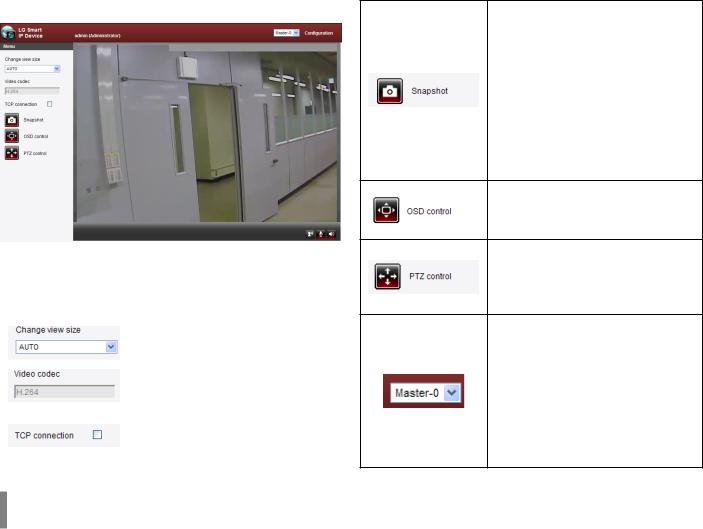
LG Smart Web Viewer Overview
Note:
The language displayed on the screen may differ by models.
Item |
Description |
|
|
|
Select the video image size from the drop- |
|
down list. |
|
The initial view size is set to AUTO. |
|
Displays the current video codec of the |
|
selected video stream (Master or Slave). |
|
|
|
Check this option as the network |
|
connection type (TCP or UDP). If you check |
|
it, the client connects to the server using |
|
TCP connection. |
Click to save the current image in JPEG format on your computer.
1.Click the [Snapshot] button and then the Snapshot window is displayed.
2.Click the [Save] button in the Snapshot window.
3.Enter the file name (JPEG format) and select the folder to save it.
4.Click the [Save] button to confirm it.
5.Click the [Close] button in the Snapshot window to close it.
Displays the Camera OSD control window. Use these buttons to setup the Camera. This button does not appear on the screen if the login is other than the administrator.
Displays the PTZ control window. Use these buttons to control the PTZ unit.
This button is not displayed with normal or anonymous user. (The function depends on the model.)
Select the video stream. From the Live view drop-down list, select the desired video image source between [Master-0] and [Slave-0].
Note:
Master and Slave are output video streams. You can set the stream configurations independently for either Master or Slave stream. This would facilitate the user to set the live view at his comfort.
6 |
Operation and settings |
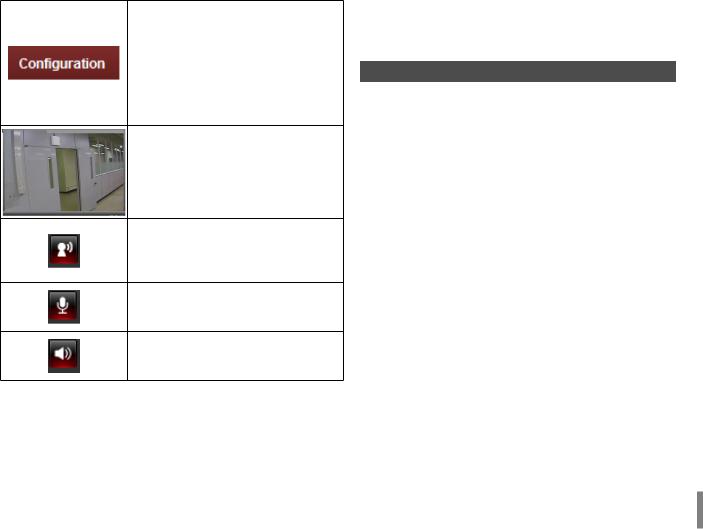
Provides all the necessary tools for setting up the device to your requirements. The user will need administrator level to do this.
Note:
If you want to exit the Configuration menu, select one of the video stream in the Live view drop-down list.
Displays the current surveillance live screen. You can monitor the camera image on the live view window of the LG Smart Web Viewer.
Click this button to connect or disconnect the audio communication between the LG IP device and the connected PC.
(Color icon: On, Gray scale icon: Off.)
Click this button to switch the microphone off and on for the computer.
(Color icon: On, Gray scale icon: Off.)
Click this button to switch the sound off and on, for the speaker of the computer.
(Color icon: On, Gray scale icon: Off.)
Configuration menu overview
The following table shows the list of menu items.
The configuration images are different from each model.
Main Menu |
Sub Menu |
Note |
|
|
|
|
Version |
|
|
|
|
|
Date & Time |
|
|
|
|
System |
Maintenance |
|
|
|
|
|
Log & Report |
|
|
|
|
|
Language |
|
|
|
|
|
Camera |
|
|
|
|
|
Stream |
|
|
|
|
|
Audio |
Option |
Audio & Video |
|
|
PTZ protocol |
Option |
|
|
|
|
|
Preset |
Option |
|
|
|
|
Motion detect |
|
|
|
|
|
Auto Tracking |
Option |
|
|
|
|
Basic |
|
|
|
|
|
RTP stream |
|
|
|
|
Network |
TCP/IP |
|
|
|
|
DDNS |
|
|
|
|
|
|
|
|
|
IP filtering |
|
|
|
|
|
SNMP |
|
|
|
|
User |
Basic |
|
|
|
|
Operation and settings |
7 |

|
Event schedule |
|
|
|
|
|
|
Event |
Event server |
|
|
|
|
||
Sensor & Relay |
Option |
||
|
|||
|
|
|
|
|
Fan |
Option |
|
|
|
|
Configuring the LG Network Camera Device
The features and options of the LG IP camera are configured through the Configuration menu.
Only administrator-level users have permission to access the Configuration menu.
Accessing the Configuration menu
Click the [Configuration] button to display the LG Smart Web Viewer configuration window.
Warning
The Configuration setup should be made by qualified service personnel or system installers.
System settings
Version
Displays the current version of Firmware, Hardware, Software and Web Client.
Date & Time
8 |
Operation and settings |
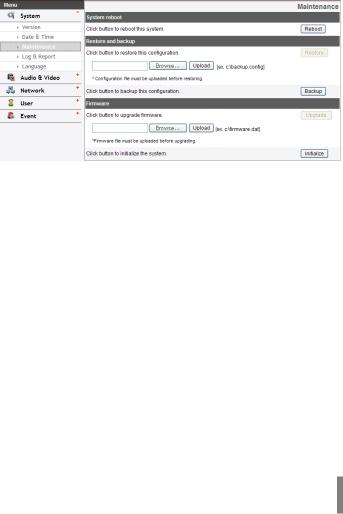
Time zone
Set the time difference from GMT in the area where the IP device is installed. Select the time zone in the area where the IP device is installed from the drop down list.
Time mode
>> Synchronize with NTP Server: Select if you want to synchronize the IP device’s date and time with those of the time server called NTP (Network Time Protocol). Specify the NTP server’s name. Click the [Test] button for connection test to the server.
>> Synchronize with personal computer: Select if you want to synchronize the IP device’s date and time with your computer.
>> Synchronize manually: Select if you want to set the IP device’s date and time manually. Select the year, month and date by clicking the calendar button. Set hour, minutes and seconds in the edit boxes.
Notes:
•When system reboot after time setting, time of system could be delayed. If you set the time correctly, set the [Synchronize with NTP server] option.
•Refer to NTP configuration as operation system of the Recording Server when the Recording Server use recording function and NTP server.
Server time
>> Server time: Displays the current date and time of the IP device.
•Save: Click this button to confirm the settings.
Maintenance
System reboot
Click the [Reboot] button to restart the IP device. It takes some minutes for the IP device to start again.
Restore and backup
>> Backup: To take a backup all of the settings. If necessary, it make possible to return to a backuped configuration.
1.Click the [Backup] button.
2.Click the [Save] button.
3.Follow the instructions on the browser to specify the folder.
4.Click the [Save] button to save the settings.
>> Restore:
1.Click the [Browse] button.
2.Find and open the file in which the configuration setting data is stored.
3.Click the [Restore] button and the system settings will be restored and reboot the system.
Operation and settings |
9 |
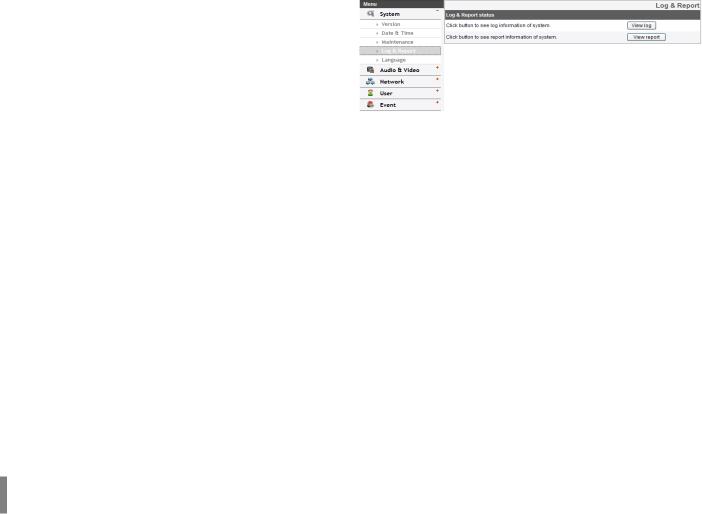
Notes:
•Backup and Restore can happen on IP device having the same version of firmware. This feature is not intended for multi-configurations or for firmware upgrades.
•[Backup] function is allowed in HTTP protocol but not in HTTPS protocol.
Firmware
>> Upgrade
1.Click the [Browse] button.
2.Find and open the firmware file.
3.Click the [Upgrade] button to update the firmware.
Note:
When you upgrade the system, it may take some minutes to be done. Do not close the browser while the upgrade is in progress. If you close the browser, it may cause a malfunction. You should wait until the confirmation window is displayed. When the upgrade is finished, the confirmation window will be displayed.
>> Initialize: The [Initialize] button should be used with caution. Clicking it will return all of the IP device’s settings to the factory default values. (Except for the Network settings, PTZ Protocol and Preset settings. The option depends on the model.)
Log & Report
Log & Report status
The System log provides a summary of the status of the IP device. The unit records the data of the software activity in a file.
>> View Log: Click this button to display the system log information.
-- Download: Click this button to see the log information of system.
>> View report: Click this button to display the report of the system.
-- Download: Click this button to see the report information of system.
Note :
The downloaded file is a UNIX type. If you open the file in Microsoft Notepad, it will display the text as if the file contained no line breaks at all.
10 |
Operation and settings |
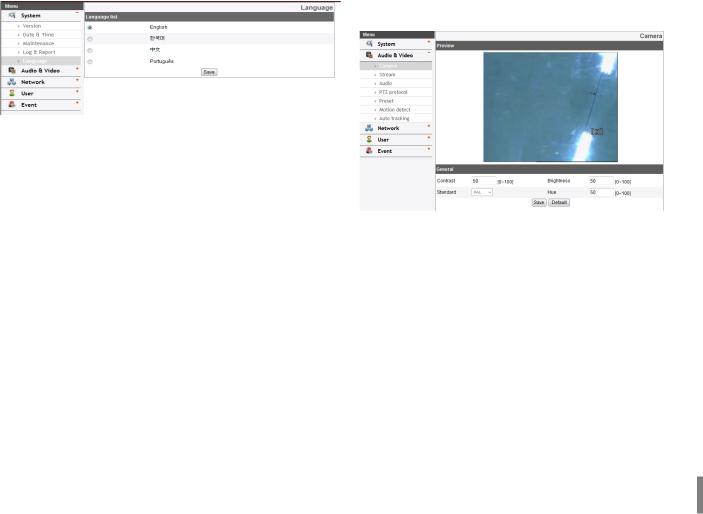
Language |
Audio & Video settings |
|
Camera |
Language list
Select a language for the LG Smart Web Viewer configuration menu and information display.
Note:
The language options may differ depending on models.
•Save: Click this button to confirm the settings.
Preview
You can preview the camera image on the preview window.
General
>> Contrast: Edit the contrast value from 0 to 100. Selecting 100 provides the image with the highest contrast.
>> Brightness: Edit the brightness of the camera. It is brighter when a large value is selected and it is darker when a small value is selected.
>> Standard: Displays the video standard of the camera. >> Hue: Edit the video Hue of the camera from 0 to 100.
•Save: Click this button to confirm the settings.
•Default: Click this button to restore the IP device back to original factory settings.
Operation and settings |
11 |

Stream
Master/Slave
>> Enable: Click to activate the stream function.
>> Deinterlacing: Click to activate the deinterlacing function.
>> Video codec: Select the video mode (Codec) from the drop down list. The viewer can choose between MJPEG and H.264.
>> Resolution: Select the output image size of the camera. >> Maximum frame rate: Set the frame rate of the image.
>> GOP size: It means “Group of Pictures”. The higher the GOP, the better is the video quality of the camera. Edit the value of GOP from 1 to 30. This setting is valid for H.264 video format only.
>> Quality: Select the Quality.
-- VBR: The bit rate may vary depending on the complexity of the video to meet the selected quality.
-- CBR: The video quality may vary in order to preserve a constant bit rate.
>> Stream quality: If the [Quality] option set to VBR, this option is displayed. Select the stream quality from the drop down box, the camera supports five types. (Highest, High, Medium, Low and Lowest)
>> Bit rate: If the [Quality] option set to CBR, this option is displayed. Edit the bit rate value from 256 kbps to 10 240 kbps.
Note:
If the ‘Bit rate’ is configured too low with high resolution, the actual frame rate will decrease because of narrow bandwidth. So you need to set or change the ‘Bit rate’ to high value.
•Save: Click this button to confirm the settings.
Audio (Option)
Audio In
>> Enable: Click the check box if you want to send the audio from the microphone input connector.
Note:
The Clients connected to the IP device remain unaffected with additional changes made in the setting.
>> Audio type: Select the codec when you send the audio from the microphone input connector.
Audio Out
>> Enable: Click the check box to output the audio from the speaker.
•Save: Click this button to confirm the settings.
12 |
Operation and settings |

PTZ protocol (Option)
Allows the user to configure different PTZ controls by using different PTZ protocols.
PTZ protocol list
>> PTZ protocol: Displays the selected PTZ protocol.
>> Edit: Click to display the PTZ protocol window. Select the PTZ protocol and then click the [Save] button. If you want to delete the protocol, click the [Remove] button.
Upload PTZ protocol
Follow the instructions below to upload PTZ protocol.
1.Click the [Browse] button, find and open the file and then click [Upload] button.
2.Click the [Add PTZ protocol] button and then the PTZ protocol will be added.
PTZ configuration
>> Enable: Click to use the PTZ protocol.
>> Camera ID: Enter the PTZ device ID. Make the same ID as the PTZ Device.
>> Pan speed: Enter the panning speed of the PTZ device in the edit box. Default value for the LG Multix Protocol is 60 and ranges from 0 to 127.
>> Tilt speed: Enter the tilting speed of the PTZ device in the edit box. Default value for the LG Multix Protocol is 60 and ranges from 0 to 127.
>> Zoom speed: Enter the zoom speed of the PTZ device to view the object close or at a distance. Default value for the LG Multix protocol is 1 and ranges from 0 to 3.
>> Focus speed: Enter the focus speed of the PTZ device to focus an object clearly near or far. Default value for the LG Multix protocol is 1 and ranges from 1 to 3.
>> Preset tour park time: Enter the parking time.
Port
>> Baud rate: Select the desired speed of communication between the IP device and the PTZ Device. Confirm selected parameter to the baud rate of the IP device.
>> Data bit: Set the number of the data bits for RS-422/RS-485 communication.
>> Parity: Select the desired parameter. The parity bit, added to the data, to perform parity check.
>> Stop bit: Enter the desired parameter. The stop bit, added to the last of data, in asynchronous communication.
•Save: Click this button to confirm the settings.
Operation and settings |
13 |
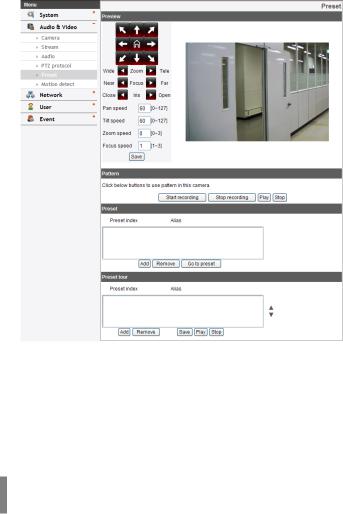
Preset (Option)
Preview
You can see the settings screen from the preview window.
1.Move the camera to the point you want by using the arrow buttons.
2.Adjust the zoom, focus or iris options.
3.Set the Pan, Tilt, Zoom or Focus speed options.
4. Click the [Save] button to confirm the settings.
Pattern
You can activate the camera in a repeating pattern. The pattern is programmed by recording your manual pan, tilt, and zoom operations. The camera stores the movements you performed in memory.
>> To record the pattern
1.Click the [Start recording] button to start the pattern recording.
2.Move the camera through the desired movement.
3.Click the [Stop recording] button to stop the pattern recording.
Note:
The available total time of pattern is different depending on the connected PTZ device and operation.
>> To play the pattern
1.Click the [Play] button to play the programmed pattern.
2.Click the [Stop] button to stop playing.
Preset
Displays the registered preset position.
•Add: Click to add a preset position.
1.Click the [Add] button.
2.Select the preset index number.
3.Enter the preset alias.
4.Click the [Save] button.
5.Repeat the steps 1 to 4 to add other positions.
Note:
If you set the HOME position, check the [Set home position] option.
14 |
Operation and settings |
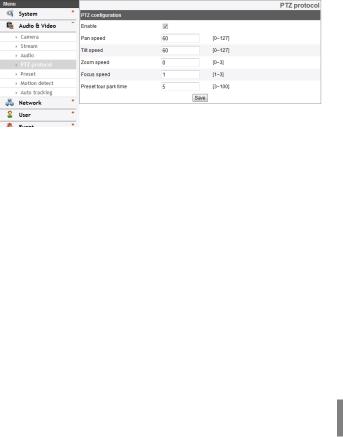
•Remove: Click to delete the preset position.
1.Select the preset from the list.
2.Click the [Remove] button. The preset will be deleted.
•Go to preset: Move to the preset position.
1.Select the preset from the list.
2.Click the [Go to preset]. The camera will be moved to the selected preset.
Preset tour
A preset tour is composed of a group of preset positions that the operator can link together in a sequence.
>> To tour the preset positions
1.Choose the preset in the [Preset].
2.Click the [Add] button in the [Preset tour].
3.Repeat the steps 1 to 2 to add another preset.
4.Click the [Save] button to confirm the preset tour.
5.Click the [Play] button to start the preset tour.
6.Click the [Stop] button to stop the preset tour.
Note:
If you control the PTZ or OSD, the preset tour will be stopped.
>> Remove: Click this button to delete the selected preset in the [Preset tour].
=============================================
PTZ protocol (LW9228/LW9226/LW9228I/LW9226I/LNP3700T/ LNP2800/LNP2800I models only)
Allows the user to configure different PTZ controls by using different PTZ protocols.
PTZ configuration
>> Enable: Click to use the PTZ protocol.
>> Pan speed: Enter the panning speed of the PTZ device in the edit box. Default value for the LG Multix Protocol is 60 and ranges from 0 to 127.
>> Tilt speed: Enter the tilting speed of the PTZ device in the edit box. Default value for the LG Multix Protocol is 60 and ranges from 0 to 127.
>> Zoom speed: Enter the zoom speed of the PTZ device to view the object close or at a distance. Default value for the LG Multix protocol is 1 and ranges from 0 to 3.
>> Focus speed: Enter the focus speed of the PTZ device to focus an object clearly near or far. Default value for the LG Multix protocol is 1 and ranges from 1 to 3.
>> Preset tour park time: Enter the parking time.
•Save: Click this button to confirm the settings.
Operation and settings |
15 |
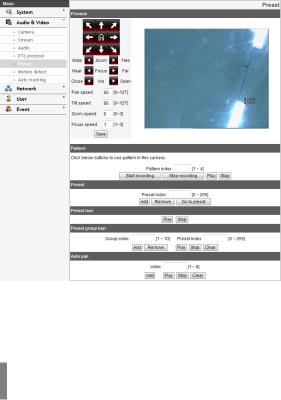
Preset (LW9228/LW9226/LW9228I/LW9226I/LNP3700T/LNP2800/ LNP2800I models only)
Note:
While configuring PATTERN/PRESET/GROUP TOUR/AUTO PAN, turn off Auto Tracking feature temporarily.
Preview
You can see the settings screen from the preview window.
1.Move the camera to the point you want by using the arrow buttons.
2.Adjust the zoom, focus or iris options.
3.Set the Pan, Tilt, Zoom or Focus speed options.
4.Click the [Save] button to confirm the settings.
Pattern
You can activate the camera in a repeating pattern. The pattern is programmed by recording your manual pan, tilt, and zoom operations. The camera stores the movements you performed in memory. LNP3700T/LNP2800/LNP2800I series are supported pattern recording up to 4. (LW9226/LW9228 series do not need to select a pattern index.)
»» To record the pattern
1.Enter the pattern number you wish to register.
2.Click the [Start recording] button to start the pattern recording.
3.Move the camera through the desired movement.
4.Click the [Stop recording] button to stop the pattern recording.
Note:
The available total time of pattern differs depending on connected PTZ device and operation.
»» To play the pattern
1.Enter the pattern number you wish to register.
2.Click the [Play] button to play the programmed pattern.
3.Click the [Stop] button to stop playing.
Preset
Preset position is the function to register camera monitoring positions (preset positions) associated with position numbers. By entering the position numbers, you can move cameras to the preset positions.
»» To register preset position
1. Enter the preset number you wish to register.
16 |
Operation and settings |

2.Move the camera to a point you wish.
3.Click the [Add] button.
4.Repeat the steps 1 to 3 to add other positions.
»» To remove the preset position
1.Enter the memorized preset index number.
2.Click the [Remove] button. The preset will be deleted.
»» Changing a picture in a preset position
1.Enter the memorized preset index number.
2.Click the [Go to preset] button. The camera moves to the preset position and the picture of the camera in that position appears on the monitor.
Preset tour
A preset tour is composed of a group of preset positions that the operator can link together in a sequence.
1.Click the [Play] button to start the preset tour.
2.Click the [Stop] button to stop the preset tour.
Note:
If you control the PTZ, the preset tour will be stopped.
Preset group tour
You can create a group using preset positions that are registered already.
»» To set the group
1.Enter the group number in the [Group index] option.
2.Enter the preset index number in the [Preset index] option.
3.Click the [Add] button.
4.Repeat the steps 2 to 3 to add other preset index number.
5.Repeat the steps 1 to 4 to set the other group index.
»» To remove the preset index from the group
1.Enter the group number in the [Group index] option.
2.Enter the preset index number in the [Preset index] option.
3.Click the [Remove] button.
4.Repeat the steps 2 to 3 to remove other preset index number.
5.Repeat the stpes 1 to 4 to set the other group index.
»» To tour the group
1.Enter the group number in the [Group index] option.
2.Click the [Play] button to start the group tour.
3.Click the [Stop] button to stop the group tour.
»» To delete a group
1.Enter the group number in the [Group index] option.
2.Click the [Clear] button. The group will be deleted.
Auto pan
You can play the camera with auto pan function.
»» To set the Auto Pan position
1.Enter the index number you wish to register.
2.Move the camera to the desired point.
3.Click the [Add] button.
4.Repeat the steps 1 to 3 to add other index number. You can set the Auto pan index number up to 8.
»» To play the auto pan
1.Click the [Play] button to start the Auto Pan function.
2.Click the [Stop] button to stop the Auto Pan function.
Note:
If you click the [CLEAR] button, all of Auto pan position will be deleted.
================================================
Operation and settings |
17 |

Motion detect
Preview
You can preview the motion detection window on the preview window.
General
>> Sensitivity: Enter the sensitivity to detect an object in motion. >> Save: Click this button to confirm the settings.
How to set the motion detect window
1.Click the [Add] button. The motion detect window is displayed. You can add the five windows maximum for motion detection area.
2.Set the [Sensitivity] option.
3.Click the edge or corner of the window box to adjust the window size for motion detection.
4.Click the [Save] button to save the settings.
Note:
•You can reset the window size. Click one of the window edge or corner and drag & drop to reset the motion detection area.
•If LSW2010, LDW2010, LVS201 models, Motion Detection can be activated when at least one of channels (Master/Slave) is enabled, Video codec is set to H.264 and GOP size is more than 2.
•If not LSW2010, LDW2010, LVS201 models, Motion Detection can be activated when Master channel is enabled, Video codec is set to H.264 and GOP size is more than 2.
18 |
Operation and settings |
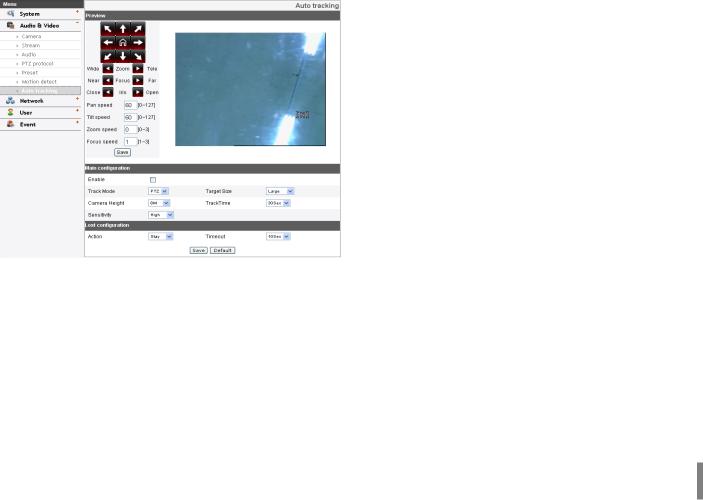
Auto Tracking (LW9228/LW9226/LW9228I/LW9226I/LNP3700T models only)
Preview
You can see the settings screen from the preview window.
1.Set the camera angle to the point you want with arrow buttons.
2.Adjust the zoom, focus options.
3.Set the Pan, Tilt, Zoom or Focus speed options.
4.Click the [Save] button to confirm the settings.
Main configuration
>> Enable: Click the check box if you want to activate this function.
>> Track Mode: During perform the Auto Tracking, track the object using PT(Pan / Tilt) or PTZ(Pan / Tilt / Zoom).
>> Target Size
-- SMALL: Make images about 1/4 of the object using Zoom feature.
-- MEDIUM: Make images about 1/2 of the object using Zoom feature.
-- LARGE: Make images about 3/4 of the object using Zoom feature.
>> Camera Height: Set to the height of the camera.
>> TrackTime: Set the maximum time object tracking.
The camera moved to the initial position after tracking the amount of time set.
>> Sensitivity: Set the sensitivity of detection of objects.
Note:
Low sensitivity setting value can be difficult to detect of small objects or movement.
Lost configuration
>> Action
-- Stay: When tracking is failed, the camera stays current position preparing re-tracking, does not return to the initial position.
-- Return: When tracking is failed, the camera returns to the initial position preparing re-tracking.
>> Timeout: When tracking is failed for the first time, It tries to re-check the object during set timeout. After that, set action is performed.
•Save: Click this button to confirm the settings.
•Default: Click this button to restore the IP device back to original factory settings.
Operation and settings |
19 |
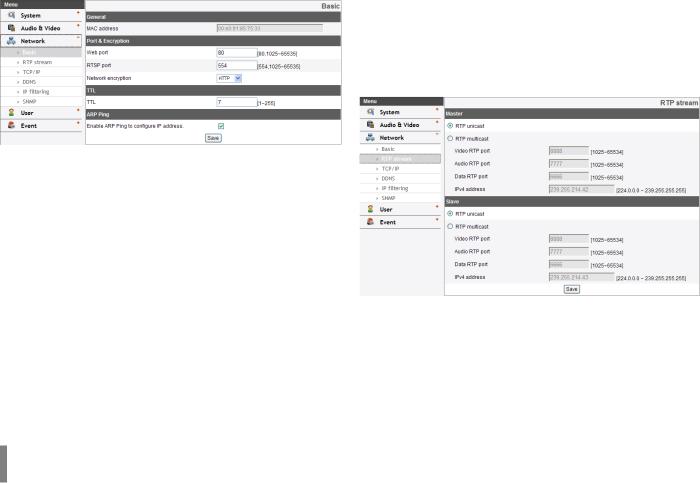
Network settings
Basic
General
>> MAC address: Displays the MAC address.
Port & Encryption
>> Web port: The default HTTP port number (80) can be changed to any port within the range 1 025 to 65 535.
>> RTSP port: Check RTSP port. The default port is 554. Other ports can be selected within the range 1 025 to 65 535.
>> Network encryption: Select the HTTP or HTTPS option for security.
Note:
The RTSP port number should not be same with the web port number.
TTL
>> TTL: This option indicates the Time-To-Live of multicast packets. The default setting is 7, and the allowed TTL range is from 1 to 255.
ARP Ping
>> Enable ARP Ping to configure IP address: Check to enable ARP ping.
•Save: Click this button to confirm the settings.
RTP stream
RTP (Real-time Transport Protocol) is an internet protocol that allows programs to manage the real-time transmission of multimedia data, via unicast or multicast.
Master / Slave
>> RTP unicast: When enabled the transmission of the data to the specified equipment happens on a network specifying a single address.
20 |
Operation and settings |
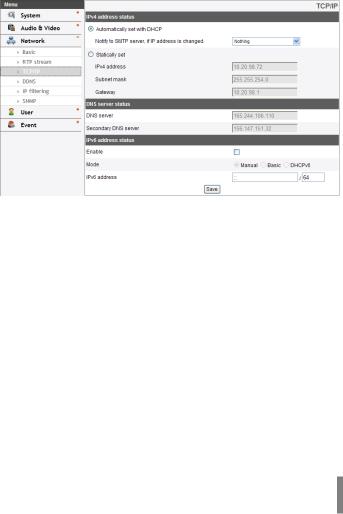
>> RTP multicast: When enabled it reduces the transmission load on the camera by making the computer of the same segment network receive the same transmission data. When multicast option is checked then select Video Port number, Audio Port number and Data port number.
-- Video RTP port: Specify the video transmission port number used for the multicast streaming.
-- Audio RTP port: Specify the audio port number used for the multicast streaming.
-- Data RTP port: Specify the VA data port number used for the multicast streaming.
-- IPv4 address: Set the IP address for RTP multicast.
Note:
Each stream using multicast needs its own pair of multicast IP address and port numbers to avoid address conflict.
•Save: Click this button to confirm the settings.
TCP/IP
IPv4 address status
>> Automatically set with DHCP: Select this option when a DHCP server is installed on the network to allow IP address assignment. With this setting, the IP address is assigned automatically.
-- Notify to SMTP server, if IP address is changed: If you select this option, the user get a notification mail telling about changing of IP of the IP device.
Note:
You should register the SMTP server on the Event server setting to set this function.
>> Statically set: Select this option when you set a fixed IP address, with this setting, specify the IP address, Subnet mask and default gateway manually.
-- IPv4 address: Enter an IP address.
-- Subnet mask: Enter a subnet mask address.
Operation and settings |
21 |
